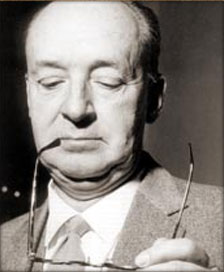Other readers see a story quite different from the apparent narrative. “Shadeans” maintain that John Shade wrote not only the poem, but the commentary as well, having invented his own death and the character of Kinbote as a literary device. According to Boyd, Andrew Field invented the Shadean theory and Julia Bader expanded it; Boyd himself espoused the theory for a time. In an alternative version of the Shadean theory, Tiffany DeRewal and Matthew Roth argued that Kinbote is not a separate person but is a dissociated, alternative personality of John Shade. (An early reviewer had mentioned that “a case might be made” for such a reading.) “Kinboteans”, a decidedly smaller group, believe that Kinbote invented the existence of John Shade. Boyd credits the Kinbotean theory to Page Stegner and adds that most of its adherents are newcomers to the book. Some readers see the book as oscillating undecidably between these alternatives, like the Rubin vase (a drawing that may be two profiles or a goblet).
Though a minority of commentators believe or at least accept the possibility that Zembla is as “real” as New Wye, most assume that Zembla, or at least the operetta-quaint and homosexually gratified palace life enjoyed by Charles Kinbote before he is overthrown, is imaginary in the context of the story. The name “Zembla” (taken from “Nova Zembla”, a former latinization of Novaya Zemlya) may evoke popular fantasy literature about royalty such as The Prisoner of Zenda. As in other Nabokov books, however, the fiction is an exaggerated or comically distorted version of his own life[citation needed] as a son of privilege before the Russian Revolution and an exile afterwards, and the central murder has resemblances (emphasized by Priscilla Meyer) to Nabokov’s father’s murder by an assassin who was trying to kill someone else.
Still other readers de-emphasize any sort of “real story” and may doubt the existence of such a thing. In the interplay of allusions and thematic links, they find a multifaceted image of English literature, criticism, or glimpses of a higher world and an afterlife.
Allusions and references
The first two lines of John Shade’s 999-line poem, “Pale Fire”, have become Nabokov’s most quoted couplet:
I was the shadow of the waxwing slain
By the false azure in the window pane
Like many of Nabokov’s fictions, Pale Fire alludes to others of his. “Hurricane Lolita” is mentioned, and “Pnin” appears as a minor character. There are many resemblances to “Ultima Thule” and “Solus Rex”, two short stories by Nabokov intended to be the first two chapters of a novel in Russian that he never continued. The placename Thule appears in Pale Fire, as does the phrase solus rex (a chess problem in which one player has no pieces but the king).
The book is also full of references to culture, nature, and literature. They include, but are not limited to:
Bobolink
Maud Bodkin
The Brothers Karamazov
Robert Browning, including “My Last Duchess” and Pippa Passes (inspired in a wood near Dulwich)
Cedar, including a colloquial American meaning, juniper
Ben Chapman. Some have said the newspaper headline “Red Sox Beat Yanks 5–4 On Chapman’s Homer” was genuine and “unearthed by Nabokov in the stacks of the Cornell Library”, but others have stated no such game occurred. However, a different player, Sam Chapman of the Philadelphia Athletics, did hit a home run in the 9th inning on September 29, 1938, to defeat the Yankees, 5–4.
Charles II of England
Charles VI of France, known as Charles the Well-Beloved and Charles the Mad
Disa orchid and the butterflies Erebia disa and E. embla (which may lead to Disa and Embla)
T. S. Eliot and Four Quartets
“Der Erlkönig”
Et in Arcadia ego
Thomas Flatman
Edsel Ford (poet) and the poem “The Image of Desire”
Forever Amber
Robert Frost and the poems “Stopping by Woods on a Snowy Evening” and possibly “Of a Winter’s Evening”
Oliver Goldsmith
Gradus ad Parnassum
Gutnish
Thomas Hardy and the poem “Friends Beyond” (for the word “stillicide”)
Bret Harte and his character Colonel Starbottle
Hebe and the poem “Vesennyaya Groza” (“Spring Thunderstorm”) by Fyodor Tyutchev
Sherlock Holmes and “The Adventure of the Empty House”
A Hero of Our Time
A. E. Housman, including “To an Athlete Dying Young”
In Memoriam A.H.H.
Strange Case of Dr Jekyll and Mr Hyde
Samuel Johnson, James Boswell, Boswell’s Life of Johnson and Hodge
James Joyce
Kalevala
John Keats, including La Belle Dame sans Merci
The Konungs skuggsjá or Royal Mirror
Krummholz
Jean de La Fontaine and “The Ant and the Grasshopper” (or cicada)
Franklin Knight Lane
Angus McDiarmid or MacDiarmid, author of Striking and Picturesque Delineations…
The Magi, including Balthasar and Melchior
Novaya Zemlya
Papilio nitra (now P. zelicaon nitra) and P. indra
Parthenocissus
Edgar Allan Poe and the poem “To One in Paradise” (for the phrase “Dim gulf”)
Alexander Pope and Jonathan Swift
Marcel Proust
François Rabelais
Red admiral butterfly, Vanessa atalanta
Alberto Santos-Dumont
Walter Scott, including “Glenfinlas, or Lord Ronald’s Coronach”, “The Lady of the Lake”, and The Pirate
Robert Southey, in particular, the Poet Laureate’s rivalry to Lord Byron as alluded to in the latter’s Don Juan dedication
Speyeria diana and S. atlantis
Thormodus Torfaeus
Waxwing
Pierinae
Word golf
William Wordsworth, including “The River Wye”, and Samuel Taylor Coleridge, including “Kubla Khan”
Lev Yashin, a “stupendous Dynamo goalkeeper”
See also The Ambidextrous Universe, a later book referencing Pale Fire which in turn triggered a reciprocal response in a subsequent Nabokov novel (Ada, 1969).
